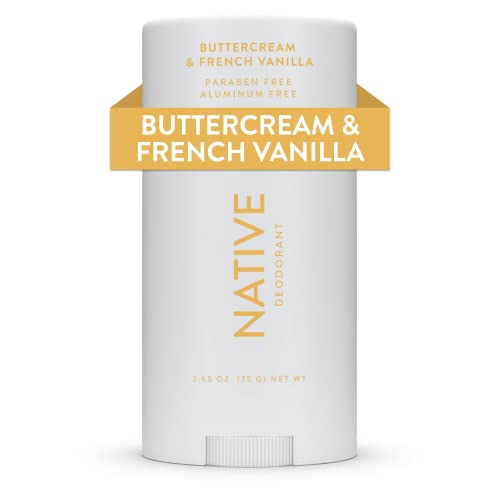
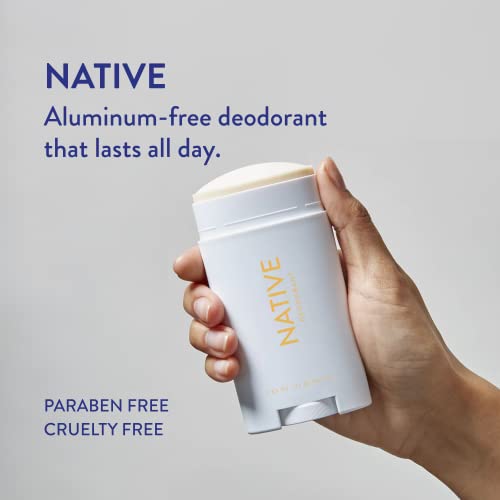
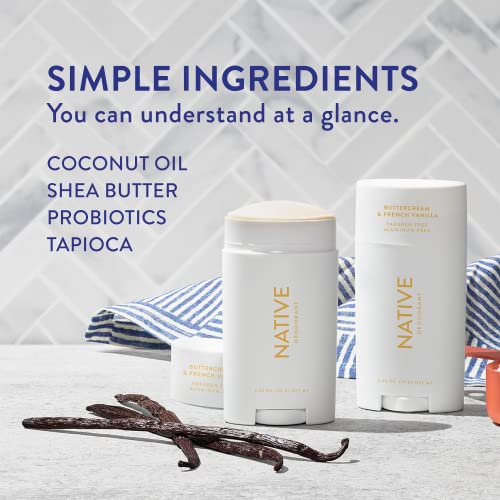
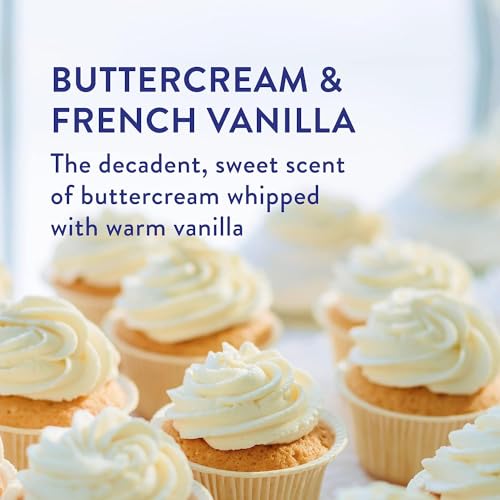
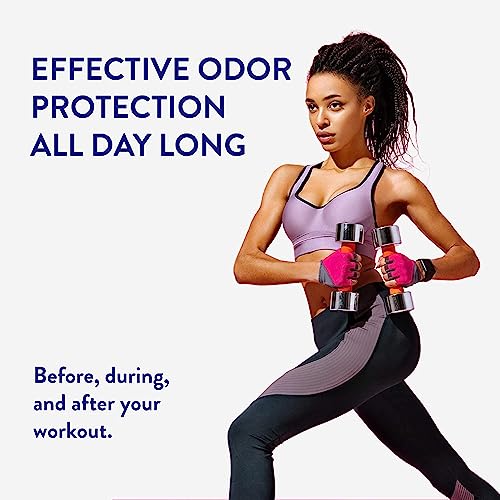

Native Deodorant - 72 Hour Odor Control, Naturally Derived Ingredients, Buttercream & Vanilla


Fragrance
High RiskFragrance refers to a mixture of aromatic compounds used in products to provide scent. It is commonly listed as 'fragrance' or 'parfum' on product labels and can serve various functions, including enhancing user experience and masking undesirable odors.
Sustai Insights
Fragrance offers functional benefits by improving product appeal; however, it poses significant health risks, notably a high likelihood of causing allergies and allergic contact dermatitis. Environmental risks include potential pollution and endocrine disruption, though its overall carcinogenicity is low. Regulatory bodies have noted concerns regarding its use, leading to a high-risk classification. Safe usage practices should be observed, and alternatives such as natural essential oils are recommended for those sensitive to synthetic fragrances.
Cyclodextrin
Low RiskCyclodextrin is a cyclic polysaccharide composed of glucose units, commonly used in pharmaceuticals and food products as a stabilizing agent and to enhance solubility. Its structure allows it to form inclusion complexes with various molecules, which aids in improving the delivery and efficacy of active ingredients.
Sustai Insights
Cyclodextrin is recognized for its ability to enhance the solubility and stability of active ingredients, making it valuable in formulations. It is considered low risk regarding health impacts, with minimal concerns for carcinogenicity, allergies, or reproductive toxicity. Environmentally, it poses low pollution potential and does not bioaccumulate. Regulatory bodies, including the FDA, have deemed it safe for use. While no significant health or environmental risks are noted, it is essential to follow usage recommendations. Overall, cyclodextrin presents a low risk profile and serves as a functional ingredient in various applications.
Ozokerite
Low RiskOzokerite is a hydrocarbon wax derived from mineral oil, primarily composed of saturated hydrocarbons. It is commonly used in cosmetic and personal care products as a thickening agent, texturizer, or to provide a glossy finish.
Sustai Insights
Ozokerite offers functional benefits as a thickener and stabilizer in formulations, contributing to product texture and application. The ingredient presents low health risks, including low concerns for carcinogenicity and allergies. Environmental impacts are minimal, with low to moderate persistence and bioaccumulation potential. Regulatory status indicates no significant restrictions, though verified products must exclude certain contaminants. Overall, ozokerite is assessed to pose low risk, with safe usage practices recommended; alternatives include plant-based waxes for more sustainable applications.
Tapioca Starch
Low RiskTapioca starch is a carbohydrate extracted from the cassava root, primarily used as a thickening agent in food products and as a binding agent in various formulations. It is known for its ability to provide a smooth texture and enhance the consistency of products.
Sustai Insights
Tapioca starch offers functional benefits such as serving as an effective thickener and stabilizer in food and cosmetic formulations. It is derived from a renewable source and is biodegradable, contributing to sustainability. Health risks are minimal, with low concerns regarding carcinogenicity, allergenic potential, and reproductive toxicity. Environmental risks are also low, with no significant pollutants or bioaccumulation identified. Regulatory bodies, including the FDA, have approved its use without significant restrictions. Overall, tapioca starch presents a low risk profile, making it a safe ingredient in various applications.
Magnesium Hydroxide
Low RiskMagnesium hydroxide is an inorganic base commonly used in various applications, including as an antacid and laxative. It serves to neutralize stomach acid and relieve constipation. It is also utilized in wastewater treatment and as a flame retardant in plastics.
Sustai Insights
Magnesium hydroxide provides effective relief from indigestion and constipation, contributing to digestive health. It is recognized for its low environmental impact and is generally regarded as safe with minimal health risks, including low concerns for carcinogenicity, allergies, and reproductive toxicity. Regulatory bodies have few restrictions on its use, classifying it as low risk overall. However, precautions should be taken to avoid excessive consumption, and alternatives like calcium carbonate may be considered for similar functions. Overall, magnesium hydroxide is assessed as low risk.
Sodium Bicarbonate
Low RiskSodium bicarbonate, commonly known as baking soda, is an inorganic compound with the formula NaHCO₃. It functions primarily as a leavening agent in baking, helping to produce carbon dioxide gas when it reacts with acids, thereby causing dough to rise. It also serves as a mild alkaline agent in various personal care products.
Sustai Insights
Sodium bicarbonate is valued for its effectiveness as a leavening agent and its role in neutralizing acidity, contributing to product stability. It is considered environmentally friendly and biodegradable. Health risks are minimal, with low concerns regarding carcinogenicity, allergies, and reproductive toxicity. It is not classified as a pollutant and poses no significant environmental hazards. Regulatory assessments indicate it is safe for use in food and cosmetic products. Overall, sodium bicarbonate carries a low risk, making it a practical choice in many applications.
Glucose
Low RiskGlucose is a simple sugar commonly derived from starches and is utilized primarily as a sweetener in food and beverages. It serves as an energy source for cellular processes and is also used in various pharmaceutical and cosmetic formulations for its humectant properties, helping to retain moisture.
Sustai Insights
Glucose offers functional benefits as a sweetener and humectant, enhancing product texture and moisture retention. Its sustainability credentials are moderate, as it is often derived from renewable sources. Health risks are low, with no significant concerns regarding carcinogenicity or allergenic potential. Environmental risks are minimal, as glucose is not considered a pollutant or bioaccumulative. Regulatory agencies, including the FDA, do not impose restrictions on glucose use, confirming its safety in approved concentrations. Overall, glucose carries a low risk profile, making it a favorable ingredient in various applications.
Acidophilus Extract
Low RiskAcidophilus extract is derived from the Lactobacillus acidophilus bacteria, commonly used in dietary supplements and fermented foods. It functions primarily as a probiotic, aiding in the maintenance of gut health by promoting a balanced intestinal microbiota.
Sustai Insights
Acidophilus extract offers functional benefits as a probiotic, supporting digestive health and immune function. It is generally recognized as safe with low concerns regarding carcinogenicity, allergies, and developmental toxicity. Environmental risks are minimal, and it is not associated with bioaccumulation. Regulatory bodies do not impose restrictions on its use. Overall, the risk level is low, and it can be safely included in health-related products, with few alternatives necessary.
Caprylic/Capric Triglyceride
Low RiskCaprylic/capric triglyceride is a mixed triester derived from coconut oil and glycerin, primarily used as an emollient and skin-conditioning agent in cosmetic formulations. It serves to improve the texture and spreadability of products while providing a lightweight, non-greasy feel on the skin.
Sustai Insights
Caprylic/capric triglyceride offers functional benefits as an effective emollient, enhancing skin hydration without clogging pores. It is biodegradable, contributing to sustainability. Health risks are low, with minimal concerns regarding carcinogenicity, allergies, or reproductive toxicity. Environmental impacts are also low, with no known pollutant status. Regulatory assessments indicate no current restrictions. Overall, this ingredient presents a low risk profile, making it a safe choice in cosmetic applications.
Cocos Nucifera (Coconut) Oil
Low RiskCocos Nucifera (Coconut) Oil is derived from the kernels of the coconut palm. It is primarily used in cosmetic formulations for its emollient and moisturizing properties, making it suitable for skin and hair care products.
Sustai Insights
Coconut oil serves as an effective moisturizer and emollient, promoting skin hydration and softness. It is sustainably sourced and biodegradable. Health risks are minimal, with low concerns regarding carcinogenicity, allergens, and reproductive toxicity. Environmental impact is also low, as it does not contribute significantly to pollution or bioaccumulation. Regulatory bodies have not issued restrictions on its use. Overall, coconut oil presents a low risk for health and environmental concerns, making it a safe ingredient in cosmetic products.
Butyrospermum Parkii (Shea) Butter
Low RiskButyrospermum parkii (shea) butter is a vegetable fat derived from the nuts of the shea tree. It is commonly used in cosmetic formulations for its emollient properties, providing moisture and improving skin texture. Additionally, shea butter is known for its ability to enhance the stability of products and deliver a creamy texture.
Sustai Insights
Shea butter offers functional benefits as an effective moisturizer, enhancing skin barrier function and texture. It is sustainably sourced and biodegradable, contributing to eco-friendliness. Health-wise, it is associated with low risks for carcinogenicity, allergies, and reproductive toxicity. Environmental impacts are minimal, with no significant pollutant potential identified. Regulatory assessments indicate no current restrictions. Overall, the ingredient presents a low risk, making it a favorable choice in cosmetic formulations.
Cyclodextrin
Low RiskCyclodextrin is a cyclic polysaccharide composed of glucose units, commonly used in pharmaceuticals and food products as a stabilizing agent and to enhance solubility. Its structure allows it to form inclusion complexes with various molecules, which aids in improving the delivery and efficacy of active ingredients.
Sustai Insights
Cyclodextrin is recognized for its ability to enhance the solubility and stability of active ingredients, making it valuable in formulations. It is considered low risk regarding health impacts, with minimal concerns for carcinogenicity, allergies, or reproductive toxicity. Environmentally, it poses low pollution potential and does not bioaccumulate. Regulatory bodies, including the FDA, have deemed it safe for use. While no significant health or environmental risks are noted, it is essential to follow usage recommendations. Overall, cyclodextrin presents a low risk profile and serves as a functional ingredient in various applications.
Ozokerite
Low RiskOzokerite is a hydrocarbon wax derived from mineral oil, primarily composed of saturated hydrocarbons. It is commonly used in cosmetic and personal care products as a thickening agent, texturizer, or to provide a glossy finish.
Sustai Insights
Ozokerite offers functional benefits as a thickener and stabilizer in formulations, contributing to product texture and application. The ingredient presents low health risks, including low concerns for carcinogenicity and allergies. Environmental impacts are minimal, with low to moderate persistence and bioaccumulation potential. Regulatory status indicates no significant restrictions, though verified products must exclude certain contaminants. Overall, ozokerite is assessed to pose low risk, with safe usage practices recommended; alternatives include plant-based waxes for more sustainable applications.
Tapioca Starch
Low RiskTapioca starch is a carbohydrate extracted from the cassava root, primarily used as a thickening agent in food products and as a binding agent in various formulations. It is known for its ability to provide a smooth texture and enhance the consistency of products.
Sustai Insights
Tapioca starch offers functional benefits such as serving as an effective thickener and stabilizer in food and cosmetic formulations. It is derived from a renewable source and is biodegradable, contributing to sustainability. Health risks are minimal, with low concerns regarding carcinogenicity, allergenic potential, and reproductive toxicity. Environmental risks are also low, with no significant pollutants or bioaccumulation identified. Regulatory bodies, including the FDA, have approved its use without significant restrictions. Overall, tapioca starch presents a low risk profile, making it a safe ingredient in various applications.
Magnesium Hydroxide
Low RiskMagnesium hydroxide is an inorganic base commonly used in various applications, including as an antacid and laxative. It serves to neutralize stomach acid and relieve constipation. It is also utilized in wastewater treatment and as a flame retardant in plastics.
Sustai Insights
Magnesium hydroxide provides effective relief from indigestion and constipation, contributing to digestive health. It is recognized for its low environmental impact and is generally regarded as safe with minimal health risks, including low concerns for carcinogenicity, allergies, and reproductive toxicity. Regulatory bodies have few restrictions on its use, classifying it as low risk overall. However, precautions should be taken to avoid excessive consumption, and alternatives like calcium carbonate may be considered for similar functions. Overall, magnesium hydroxide is assessed as low risk.
Sodium Bicarbonate
Low RiskSodium bicarbonate, commonly known as baking soda, is an inorganic compound with the formula NaHCO₃. It functions primarily as a leavening agent in baking, helping to produce carbon dioxide gas when it reacts with acids, thereby causing dough to rise. It also serves as a mild alkaline agent in various personal care products.
Sustai Insights
Sodium bicarbonate is valued for its effectiveness as a leavening agent and its role in neutralizing acidity, contributing to product stability. It is considered environmentally friendly and biodegradable. Health risks are minimal, with low concerns regarding carcinogenicity, allergies, and reproductive toxicity. It is not classified as a pollutant and poses no significant environmental hazards. Regulatory assessments indicate it is safe for use in food and cosmetic products. Overall, sodium bicarbonate carries a low risk, making it a practical choice in many applications.
Glucose
Low RiskGlucose is a simple sugar commonly derived from starches and is utilized primarily as a sweetener in food and beverages. It serves as an energy source for cellular processes and is also used in various pharmaceutical and cosmetic formulations for its humectant properties, helping to retain moisture.
Sustai Insights
Glucose offers functional benefits as a sweetener and humectant, enhancing product texture and moisture retention. Its sustainability credentials are moderate, as it is often derived from renewable sources. Health risks are low, with no significant concerns regarding carcinogenicity or allergenic potential. Environmental risks are minimal, as glucose is not considered a pollutant or bioaccumulative. Regulatory agencies, including the FDA, do not impose restrictions on glucose use, confirming its safety in approved concentrations. Overall, glucose carries a low risk profile, making it a favorable ingredient in various applications.
Acidophilus Extract
Low RiskAcidophilus extract is derived from the Lactobacillus acidophilus bacteria, commonly used in dietary supplements and fermented foods. It functions primarily as a probiotic, aiding in the maintenance of gut health by promoting a balanced intestinal microbiota.
Sustai Insights
Acidophilus extract offers functional benefits as a probiotic, supporting digestive health and immune function. It is generally recognized as safe with low concerns regarding carcinogenicity, allergies, and developmental toxicity. Environmental risks are minimal, and it is not associated with bioaccumulation. Regulatory bodies do not impose restrictions on its use. Overall, the risk level is low, and it can be safely included in health-related products, with few alternatives necessary.
Fragrance
High RiskFragrance refers to a mixture of aromatic compounds used in products to provide scent. It is commonly listed as 'fragrance' or 'parfum' on product labels and can serve various functions, including enhancing user experience and masking undesirable odors.
Sustai Insights
Fragrance offers functional benefits by improving product appeal; however, it poses significant health risks, notably a high likelihood of causing allergies and allergic contact dermatitis. Environmental risks include potential pollution and endocrine disruption, though its overall carcinogenicity is low. Regulatory bodies have noted concerns regarding its use, leading to a high-risk classification. Safe usage practices should be observed, and alternatives such as natural essential oils are recommended for those sensitive to synthetic fragrances.
Caprylic/Capric Triglyceride
Low RiskCaprylic/capric triglyceride is a mixed triester derived from coconut oil and glycerin, primarily used as an emollient and skin-conditioning agent in cosmetic formulations. It serves to improve the texture and spreadability of products while providing a lightweight, non-greasy feel on the skin.
Sustai Insights
Caprylic/capric triglyceride offers functional benefits as an effective emollient, enhancing skin hydration without clogging pores. It is biodegradable, contributing to sustainability. Health risks are low, with minimal concerns regarding carcinogenicity, allergies, or reproductive toxicity. Environmental impacts are also low, with no known pollutant status. Regulatory assessments indicate no current restrictions. Overall, this ingredient presents a low risk profile, making it a safe choice in cosmetic applications.
Cocos Nucifera (Coconut) Oil
Low RiskCocos Nucifera (Coconut) Oil is derived from the kernels of the coconut palm. It is primarily used in cosmetic formulations for its emollient and moisturizing properties, making it suitable for skin and hair care products.
Sustai Insights
Coconut oil serves as an effective moisturizer and emollient, promoting skin hydration and softness. It is sustainably sourced and biodegradable. Health risks are minimal, with low concerns regarding carcinogenicity, allergens, and reproductive toxicity. Environmental impact is also low, as it does not contribute significantly to pollution or bioaccumulation. Regulatory bodies have not issued restrictions on its use. Overall, coconut oil presents a low risk for health and environmental concerns, making it a safe ingredient in cosmetic products.
Butyrospermum Parkii (Shea) Butter
Low RiskButyrospermum parkii (shea) butter is a vegetable fat derived from the nuts of the shea tree. It is commonly used in cosmetic formulations for its emollient properties, providing moisture and improving skin texture. Additionally, shea butter is known for its ability to enhance the stability of products and deliver a creamy texture.
Sustai Insights
Shea butter offers functional benefits as an effective moisturizer, enhancing skin barrier function and texture. It is sustainably sourced and biodegradable, contributing to eco-friendliness. Health-wise, it is associated with low risks for carcinogenicity, allergies, and reproductive toxicity. Environmental impacts are minimal, with no significant pollutant potential identified. Regulatory assessments indicate no current restrictions. Overall, the ingredient presents a low risk, making it a favorable choice in cosmetic formulations.
Experience the delightful fusion of Buttercream & French Vanilla with Native Deodorant, a personal care essential that combines naturally derived ingredients for 72-hour odor control. This aluminum-free formula is perfect for both men and women, ensuring effective protection against odor without compromising on safety or comfort.
- Naturally Derived Ingredients: Crafted with baking soda, coconut oil, and shea butter, this deodorant nourishes your skin while keeping you fresh all day.
- Effective Protection: Developed through extensive testing, this formula offers a light yet powerful defense against odor, making it ideal for active lifestyles.
- Easy Application: The solid stick design glides on smoothly, ensuring a mess-free experience with every use.
- Cruelty-Free Commitment: Native proudly never tests on animals, supporting ethical practices in personal care.
- Versatile Scents: Available in seasonal fragrances, this deodorant caters to diverse preferences, making it a perfect choice for everyone.
Subscribe & Save with Sustai
- Best Price Guarantee: Always enjoy the lowest prices on sustainable home essentials.
- No Surprises: We’ll notify you before shipping. No hidden fees, ever.
- You’re in Charge: Change, pause, or cancel your subscription anytime with ease.
- Eco-Friendly Deliveries: Our grouped shipments mean less packaging and lower emissions.
Join us on a sustainable journey. Special offers for a limited time! Prices and promotions may change.
Recommended Products
Experience the delightful fusion of Buttercream & French Vanilla with Native Deodorant, a personal care essential that combines naturally derived ingredients for 72-hour odor control. This aluminum-free formula is perfect for both men and women, ensuring effective protection against odor without compromising on safety or comfort.
- Naturally Derived Ingredients: Crafted with baking soda, coconut oil, and shea butter, this deodorant nourishes your skin while keeping you fresh all day.
- Effective Protection: Developed through extensive testing, this formula offers a light yet powerful defense against odor, making it ideal for active lifestyles.
- Easy Application: The solid stick design glides on smoothly, ensuring a mess-free experience with every use.
- Cruelty-Free Commitment: Native proudly never tests on animals, supporting ethical practices in personal care.
- Versatile Scents: Available in seasonal fragrances, this deodorant caters to diverse preferences, making it a perfect choice for everyone.

You can have at most 2 Sustainable Steals products in your cart
Customer Reviews
Customers’ View
Customers appreciate the pleasant and subtle scent of the Buttercream & Vanilla deodorant, noting its effectiveness in odor control while being gentle on the skin. Many highlight that the product is aluminum-free and crafted with naturally derived ingredients, making it a favorable choice for health-conscious consumers. Users frequently mention the deodorant's ability to keep them feeling fresh throughout the day, although opinions vary on its longevity, with some feeling it doesn’t last the full 72 hours as advertised. Additionally, while the deodorant is praised for its quality, some customers express concerns about potential staining on clothing, indicating a need for caution with lighter fabrics. Overall, the product aligns well with sustainable and eco-friendly values, providing a reliable option for those seeking effective and safer personal care choices.
AI-generated from the text of customer reviewsThis product has no reviews yet.




